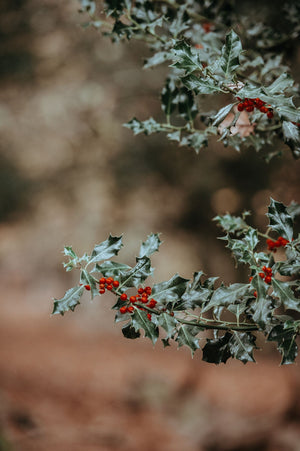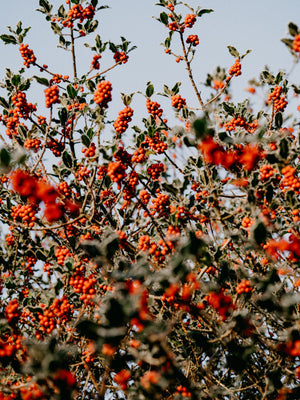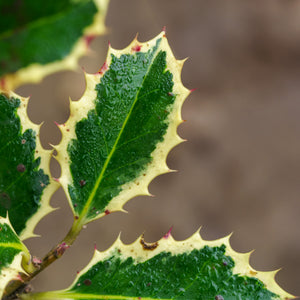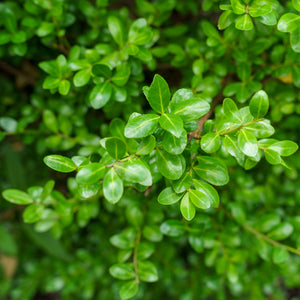The Holly Guide
Holly plants exude timeless elegance and enchantment in any landscape, captivating the eye with their glossy green leaves and vibrant berries. Holly's versatility makes it perfect for serene sanctuaries or captivating centerpieces, leaving a lasting impression. Its evergreen nature adds year-round interest, while its colorful berries provide visual allure. Adaptability to diverse soil types and sunlight conditions makes holly suitable for various garden settings. With minimal maintenance, holly plants can be shaped into hedges, borders, or stand-alone specimens. Embrace the holiday spirit by incorporating holly plants into festive decorations, adding elegance to wreaths, garlands, and centerpieces, evoking warmth and joy.

About
Holly plants, belonging to the Ilex genus, encompass a diverse group of evergreen shrubs and trees renowned for their timeless beauty and ecological significance. With numerous recognized species, holly plants can be found in various regions around the world, including North America, Europe, and Asia.
These magnificent plants are characterized by their glossy leaves, spiny edges, and vibrant berries, which add visual interest and charm to any landscape. Holly plants play a vital role in supporting local ecosystems, providing food and shelter for a wide range of wildlife. Their berries, which often persist throughout the winter months, serve as an important food source for birds and other small animals. The dense foliage of holly plants also offers nesting sites and protection for various bird species.
With their adaptability to different soil types and sunlight conditions, holly plants can thrive in diverse environments, from woodlands to urban gardens. Whether used as decorative elements, hedges for privacy, or foundation plantings, holly plants bring a touch of elegance and natural beauty to any setting.
Popular species of holly plants include the American holly (Ilex opaca), with its lustrous dark green leaves and bright red berries, and the English holly (Ilex aquifolium), known for its spiny leaves and abundant clusters of red berries.
By incorporating holly plants into your landscape, you not only enhance its aesthetic appeal but also contribute to the preservation of these remarkable plants and the ecosystems they support.

Planting
Holly plants have specific planting requirements to ensure their successful establishment and growth. Here are some general guidelines for planting and caring for holly plants:
Soil: Holly plants thrive in well-drained soil that is slightly acidic, with a pH between 5.0 and 6.5. Prepare the planting site by loosening the soil and incorporating organic matter to improve drainage and enhance fertility. Avoid heavy clay soils that can retain excessive moisture.
Sunlight: Holly plants prefer full sun to partial shade. Select a location that receives at least four to six hours of direct sunlight per day. However, they can tolerate some shade, especially in hotter climates where partial shade can help protect them from excessive heat and sunburn.
Watering: Adequate watering is crucial during the establishment phase. After planting, water the holly plant thoroughly and deeply. Provide regular irrigation, especially during dry periods, to ensure the roots receive sufficient moisture. Water deeply once or twice a week, allowing the soil to dry out slightly between waterings. Avoid overwatering, as it can lead to root rot.
Mulching: Apply a layer of organic mulch around the base of your holly plant to conserve moisture, suppress weed growth, and regulate soil temperature. Use wood chips, bark, or compost as mulch, ensuring it is a few inches away from the trunk to prevent moisture buildup and potential rotting.
Pruning: Holly plants generally require minimal pruning. Remove any dead, damaged, or diseased branches to maintain a healthy and attractive shape. Prune during late winter or early spring before new growth emerges. Use clean and sharp pruning tools to make precise cuts and minimize the risk of infections.
By following these planting and care guidelines, you can ensure the successful establishment and thriving growth of your holly plants. With proper care, your holly plants will enhance your landscape with their evergreen beauty and festive berries for years to come.

Care
Holly trees require specific care to ensure their optimal growth and health. Here are some general guidelines for the care of holly trees:
Watering: During the growing season, provide regular watering to your holly trees. Aim for about one inch of water per week, adjusting as needed based on rainfall. It's important to water deeply and thoroughly to promote deep root growth. Avoid shallow watering, which can lead to shallow root development and stress the tree.
Pruning: Holly trees generally require minimal pruning. However, you can remove any dead or damaged branches to maintain the tree's overall health and appearance. Prune during late winter or early spring before new growth emerges. Use clean and sharp pruning tools to minimize the risk of damaging the tree. Regular pruning can help shape the tree and promote a dense and compact form.
Fertilizing: Fertilizing can benefit the growth and vigor of holly trees. Apply a balanced, slow-release fertilizer in the spring or early summer, following the recommended application rates and timing provided by the manufacturer. Avoid excessive fertilization, as it can lead to excessive foliage growth and weaken the tree. Use a conservative approach and adjust the fertilizer amounts based on the tree's needs.
Soil and Sunlight: Holly trees thrive in well-drained soil that is slightly acidic. They can tolerate a range of soil types but prefer fertile and moist soil. Provide full sun to partial shade for holly trees, with at least four to six hours of direct sunlight each day. Partial shade can be beneficial, especially in hotter regions, to protect the tree from excessive heat and sun exposure.
Mulching: Apply a layer of organic mulch around the base of your holly tree, leaving a few inches of space around the trunk. Mulch helps conserve moisture, suppress weed growth, and regulate soil temperature. Use wood chips, bark, or compost as mulch, ensuring it doesn't touch the trunk to prevent moisture accumulation and potential rotting.
Pests and Diseases: Holly trees are generally resistant to pests and diseases. However, it's important to monitor for common issues such as leaf spot or scale insects. Regularly inspect your tree for any signs of damage or disease and take appropriate measures if needed. Maintaining overall tree health through proper care and maintenance can help prevent and manage pest and disease issues.
By following these basic care guidelines, your holly trees will thrive and bring beauty, greenery, and a touch of elegance to your landscape for years to come.

How To Use
Holly plants offer versatility and can be used in various ways to enhance your landscape. Here are some recommendations based on their characteristics:
Focal Point: Holly makes an excellent focal point in your landscape due to its evergreen foliage and vibrant berries. Plant a single holly in a prominent location to create a visually striking centerpiece that adds interest and beauty to your garden.
Privacy Hedge: Take advantage of the dense growth habit of holly to create a natural privacy hedge. Plant them in a row along your property line to create a living barrier that screens out unwanted views and provides privacy for your outdoor space.
Container Planting: Holly is well-suited for container planting, making it a versatile choice for patios, balconies, or small gardens. Choose compact holly varieties and plant them in large pots or containers to create a stylish and manageable display.
Mixed Borders: Incorporate holly into mixed borders and plant them alongside other shrubs, perennials, or ornamental grasses. Its glossy foliage and contrasting berries add texture, color, and year-round interest to the garden composition.
Wildlife Attraction: Holly is valuable for attracting wildlife, especially birds, who feed on the berries and seek shelter in its dense branches. Plant holly to create a habitat that supports local wildlife and brings a lively and natural element to your garden.
Holiday Decorations: Holly is synonymous with festive holiday decorations. Use the branches, with their glossy green leaves and bright red berries, to create wreaths, garlands, or table centerpieces during the holiday season. Holly adds a touch of traditional charm to your home decor.
When selecting holly for your landscape, consider its growth habit, size, and environmental requirements. Ensure it is planted in areas that provide the appropriate amount of sunlight and well-drained soil. With its evergreen beauty and multiple uses, holly is a wonderful addition that will enhance the visual appeal and versatility of your outdoor space.
Conclusion
Holly plants are a captivating and versatile addition to any landscape. With their vibrant foliage, attractive form, and cultural significance, holly plants are highly valued for their beauty and practical uses. By following proper planting and care practices, you can unlock the full potential of holly plants to enhance your outdoor space and leave a lasting impression. Whether you desire a striking focal point or a shaded retreat, holly plants can serve various roles in your landscape. Plant a single holly plant to showcase its splendor and lush foliage, or group multiple holly plants together to create a visually stunning display. Holly plants also provide excellent year-round greenery, making them ideal for planting near outdoor seating areas, patios, or decks, where they can create a refreshing and inviting atmosphere. In addition to their ornamental value, holly plants offer practical benefits, such as providing shelter and food for wildlife. With their beauty, functionality, and ecological significance, holly plants bring joy and a touch of natural charm to your outdoor environment.











